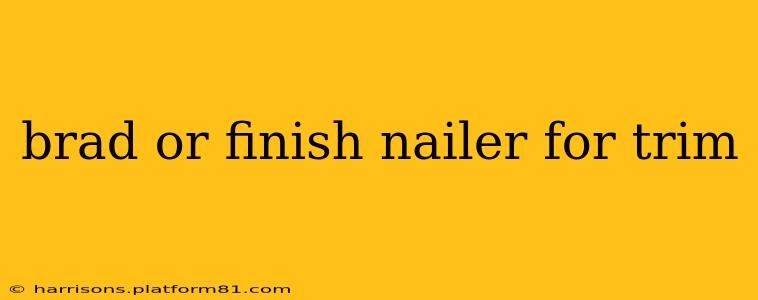Brad Nailer vs. Finish Nailer for Trim: Which is Right for You?
Choosing between a brad nailer and a finish nailer for trim work can seem daunting, but understanding their key differences simplifies the decision. Both are pneumatic tools used for fastening small nails, but they excel in different scenarios. This guide will help you determine which is the best tool for your trim installation project.
What is a Brad Nailer?
A brad nailer drives thin, small-gauge nails, typically ranging from 18-gauge to 23-gauge. These nails are ideal for less demanding applications where holding power isn't paramount. Brad nailers are known for their ability to create almost invisible fastener holes, making them perfect for delicate trim work where you want a clean finish. They're generally less expensive than finish nailers.
What is a Finish Nailer?
Finish nailers also drive small nails, but generally use thicker nails (typically 15- to 18-gauge). They offer greater holding power than brad nailers, making them suitable for heavier trim or applications where the fastener needs to withstand more stress. While the nail holes are still relatively small, they are slightly larger than those from a brad nailer, making them slightly more visible after installation.
What size nails do brad nailers and finish nailers use?
This is a crucial distinction. Brad nailers typically use nails ranging from 5/8 inch to 2 inches, while finish nailers commonly use nails from 1 inch to 2 1/2 inches. The nail length you choose depends on the thickness of your trim and the material you're fastening it to. Longer nails provide greater holding power but can also increase the risk of damaging the underlying material.
What is the difference in the size of the nail holes?
As mentioned previously, brad nailers create smaller nail holes, resulting in a cleaner, less visible finish. Finish nailers, while still producing small holes, create slightly larger ones due to the thicker gauge nails they use. This is a key consideration when choosing between the two, especially for fine trim work where minimizing nail hole visibility is a priority.
Which is better for hardwood trim?
For hardwood trim, a finish nailer is generally the better choice. Hardwood is denser and requires greater holding power, which finish nailers provide due to their thicker nails. A brad nailer might not provide sufficient holding strength, risking the trim coming loose over time.
Which is better for softwood trim?
With softwood trim, you have more flexibility. Both brad nailers and finish nailers can effectively fasten softwood, but a brad nailer might be preferred for its ability to create smaller, less visible nail holes, leading to a cleaner finish. If your softwood trim is thicker or will be subjected to more stress, a finish nailer might be more appropriate.
Which is easier to use?
Both brad and finish nailers are relatively easy to use, particularly for those with some experience using pneumatic tools. However, brad nailers are often considered slightly easier to maneuver due to their smaller size and lighter weight. This makes them preferable for working in tighter spaces or on more intricate trim details.
Which is more expensive?
Generally, finish nailers tend to be slightly more expensive than brad nailers due to their more robust construction and ability to handle larger nails. However, the price difference isn't usually significant.
In conclusion, the best choice between a brad nailer and a finish nailer for your trim work depends largely on the type of trim (hardwood vs. softwood), its thickness, and the desired level of finish. Weigh the pros and cons carefully to select the tool that best suits your needs and project. Considering the specific requirements of your project will ensure a successful and professional-looking result.
